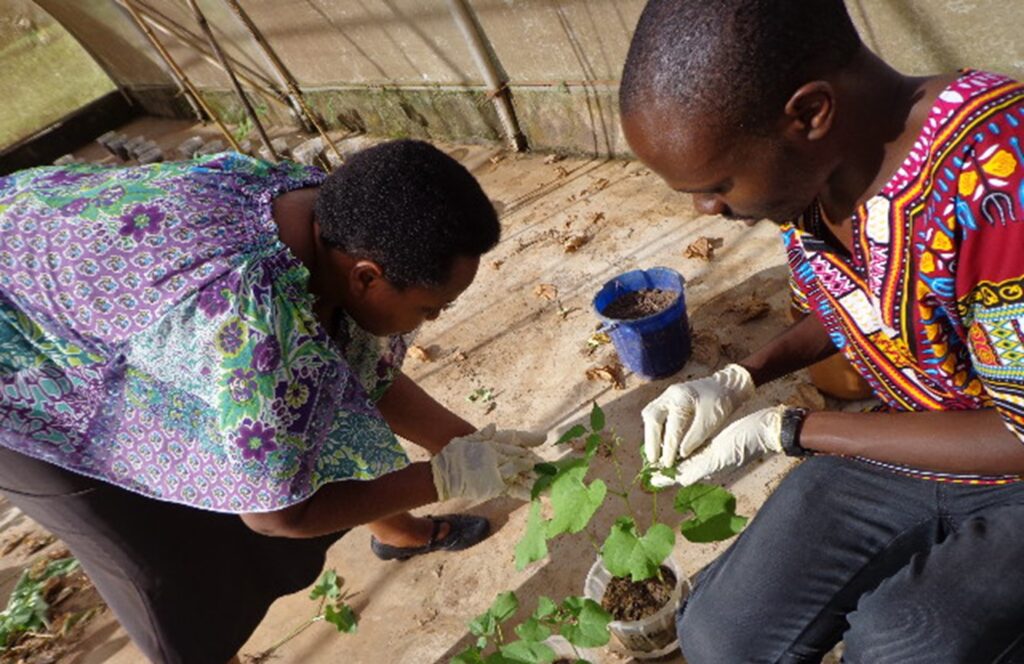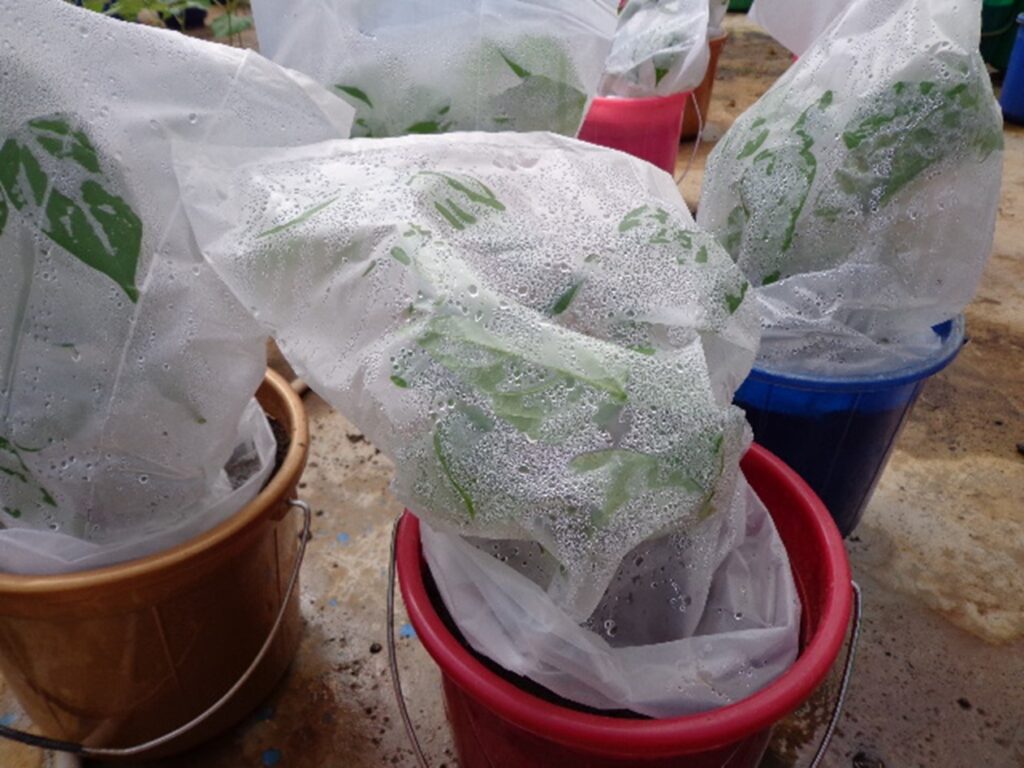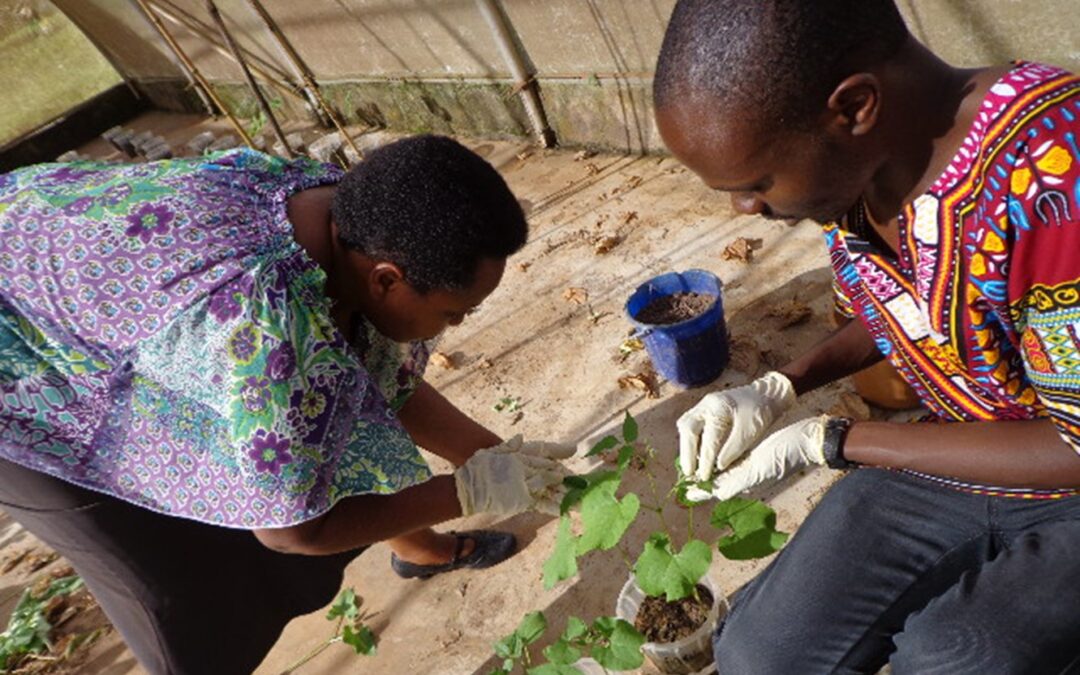by Kato, F., Male, A., Amongi, W., Odama, R., Musoke, S., Acam, C., Nababi, H., Nakyazi, B., Naluwooza, C., Kabwama, A., Wekhichu, J., Ndati, J. and Mukankusi, C.
Disease phenotyping is a technique to characterize the diseases of the crops using the physical methods of identification, monitoring the disease infectability, and assessing its severity. This is through artificial or natural inoculation of the pathogen under an accurate monitoring of the condition. This can be performed under controlled conditions such as glasshouse or screen house or in the field through monitoring different plant development stages which varies from disease to disease.
Among the most common foliar bean diseases and their causative agents that are characterized are: Anthracnose caused by Colletotrichum lindemuthianum, Angular leaf spot (ALS) caused by Pseudocercospora griseola, common bacterial blight (CBB) caused by Xanthomonas axonopodis pv phaseoli and its fuscan variants, bean rust caused by Uromyces appendiculatus, and viruses caused by Potyviruses. These diseases produce different symptoms on the leaves and pods which appear lesion like and pustules that coalesce depending on the prevailing favorable conditions. The bean program, Pan Africa Bean Research Alliance (PABRA) together with partners have been working on the above to determine the best solutions to the pathogens.
Foliar disease phenotyping is done to either characterize the highly virulent isolate or strain from the set of collections or to determine the resistance of the genotypes under study. This can be done in either the screen house under controlled conditions or in the farmers’ fields. However, since PABRA receives germplasm from various partners within the region or internationally, evaluation of all incoming germplasm for foliar diseases is routinely done to identify any potential sources of resistance to the most common economic foliar disease in the geographical location. This is done by using assessment scales especially the disease evaluation scale of (1-9) which depicts a continuum of disease severity. Any promising lines identified are then incorporated in a breeding scheme to develop disease resistant breeding lines with the best bean lines maintaining a range of 1-3 disease score.
Most of the foliar diseases thrive under conditions of high (>85%) relative humidity (RH) and low temperature (< 20 o C). Such conditions are simulated in the screenhouses at Kawanda. For several years, plants were covered with transparent plastic bags immediately after mechanical inoculation of the pathogens onto the leaves and left for 4 days to allow disease development (Fig. 1 and 2.)

Figure 1. The pathogen is being applied on to the bean leaves by the technician in the screen house.

Figure 2. The inoculated bean seedlings with the pathogen covered with transparent plastic bags in the screenhouse.
Although this method resulted in infectivity of the plants, it was quite slow, and infection is not homogeneous due to the variation in environmental conditions. Therefore, to hasten the process by which the foliar diseases manifest and to have a uniform distribution of disease especially the Anthracnose disease that progresses severely at lower temperatures, a simple, cost effective and efficient semi-permanent disease screening chamber was designed. The structure has no windows and its interior houses an air conditioner to provide the ambient temperatures of below 20oC, water sprinklers to maintain high RH, and benches on which pots holding the plants are placed. (Fig. 4).
Figure 4. The improved disease screening humidity chamber at Alliance Kawanda .
Figure 5. The inoculated bean plants with pathogens showing characteristic symptoms of the respective foliar diseases, Angular leaf spot (Left), Anthracnose (middle) and common bacterial blight (Right) in the screenhouse at Alliance Kawanda .
The advantage of these phenotyping-platforms allows the quantitative, both destructive and non-destructive analysis of bean crop varieties and germplasms under controlled environmental conditions. While the data collection is very compatible with the digital collection tools through use of electron devices such as the tablets and androids.
This disease screening chamber for foliar diseases has helped the breeding team at Kawanda identify the most virulent and aggressive pathogenic strains and races prevailing in the different geographical agro-ecologies of Uganda and identification of early selection of the different lines with sources of disease resistance.



